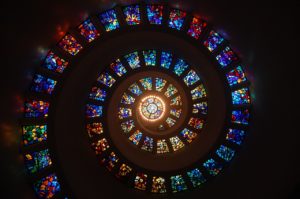The use of the world frame transferred to common language to indicate the relationship between an object and its environmental context gives some idea of the importance of what is commonly referred to as the container with regard to the contained. Just as in the case of a building one notes the harmony with the surrounding landscape or urban framework, so with a painting should one observe how the frame is in tone both with the subject matter of the picture itself and with the surrounding wall, since the frame has the double function of completing the work of art and at the same time harmonizing with the space around it.
The fact that the word frame (Italian word cornice which, apart from the architectural significance, also means picture frame) is used in architectonic glossaries to indicate the crown of a building (derived from the Greek word coronis) and in the case of the classic temple the part of the pediment above the frieze, explains the rapport it has with space. This nexus with the architecture is a constant factor accompanying the history of the frame, given that the letter has always followed the developments and character of contemporary architecture.
The protective function of the frame should also be born in mind since this has been determining factor in its history. The frame was invented for the specific function of protecting precious objects from the ravages of time as well as adding a finishing touch. In fact, the first frames belong more to the goldsmith’s field than the one of woodworkers, and the frames were made up of gems and enamels on a gold background.
The thirteenth century saw the first use of wooden frames, carved in the wood of the paintings itself and decorated and decorated with gold leaf over a red under varnish which oft remains visible today as a proof of the authenticity of the gold leafing.
An example of the 13th century frame is that of the Madonna dei Rucellai by Duccio di Buoninsegna in the Uffizi.
In the 14th century the frame blends in with contemporary gothic architecture, thus becoming ever more elaborate and decorative and acquiring the character of a craft in its own right, the work of increasingly expert carvers able to blend the material to their inventive wills. It was in Venice that the first real dynasty of intajader was created, the Moranzons, who frequently signed the frame alongside the painter and were respected as real artists.
From Venice the art of intaglio spread throughout the Central Italy to Umbria, Le Marche and Florence.
The classical style of the renaissance palace of the 15th century inspired the so called anconetta or altar piece, often crowned by a tympanum and enriched with gilded decorative motifs moulded from a paste of marble dust, plaster and glue, similar to those found on the matrimonial chests of the period.
Inspired by mannerist architecture is the frame known as tabernacolo, characterized by semi-precious stones and by spirals which emphasize the vertical movement of the piece.
An original creation of the Tuscan artisans of the Renaissance is the round frame or tondo, whose origin may be traced to the imagines clipaetae the painted shields enriched with naturalistic motifs derived from the plastic arts of the time, like the wreaths of fruits around the glazed terracotta plaques made by della Robbia family. An example of the tondo in carved, gilded wood is that framing the Sacra Famiglia by Luca Signorelli and also that of the Tondo Doni by Michelangelo in the Uffizi.
During the 16th century there was no lack of the frames known as a cassetta (box frames) made of walnut and often picked out in gold and the so called sansovina frames named after their designer, the artist Jacopo Sansovino, recognized by its spirals, rosettes and small carved heads and sometimes further enriched with festoons after wall decorations of the period.
In the 17th century there was a proliferation of princely collections in which the frame formed an integral part in the furnishing of the space given to the paintings. Italian galleries were dominated by the so called salvadore frame, named after the Painter Salvatore Rosa who invented them; these had a smooth and grooved outline with no decoration other than gilding, while in the north, particularly in the Low Countries the Flammleisten prevailed, in black stained pear wood, used mainly to frame landscapes, portraits and genre scenes.
A notable characteristic of the 17th century baroque frame is the presence of intaglio in which the craver competes, if not identifies himself with the sculptor in boasting fantastic decorative motifs derived chiefly from prints inspired by the works of nature: acanthus leaves, fish scales, dragons, lions, heads, seem to be devouring the frame wood and mingle in a continues dynamism of the form.
The imagination of the cravers was also subject to the directives of whoever commissioned the frame, and the latter often invited the artisan to take inspiration from the subject matter of the painting itself.
In the 18th century the mirror took over the role in furnishing previously occupied by the frame of preceding centuries.
The rococo style triumphed with the Luis XV frame which spread from France throughout Europe and characterized the furnishing of the era with its decorative motifs of fans, shells, and heads, often modeled in gilded stucco.
Towards the end of the century neo-classical taste imposed raw materials such as rare marbles and tortoise shell, appliqu work in gilded bronze and also severe, rigid lines inspired by the furniture of the period. Indeed it is from furniture that frames continue to take their characteristic elements throughout the 19th century.
Yhe Empire style with its typical leitmotifs, palms, leaves, triglyphs, garlands, etc.., passed from the console to the picture frame which once again became smooth with no intaglio work. A characteristic of empire style bow frame was a garland motif knotted with a ribbon.
The 15th century tondo was modified and became smooth, set with an outer square frame with gilded bosses at the corners.
With the reevaluation of the gothic style comes a re-launching of the intaglio in wood; in some cases the frame underlines the symbolic value of the painting where the decorative details underline the painter’s religious vision of life.
In the second half of 19th century the frame continues to be inspired by contemporary architecture.
In the last ten years with the high cost labor and craftsmanship industrially produced frames with a ready made basic form have come into use, their decorative function being fulfilled only by the color where it was once fulfilled by intaglio work.
Submitted by:Cornici MaselliCornici Maselli artisan workshop in Florence, Italy |





